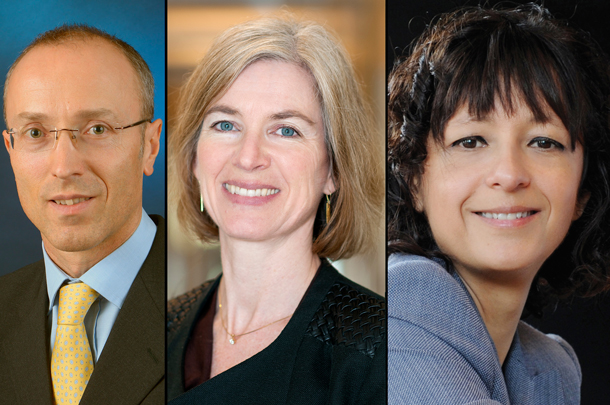The winners of this year’s Meira and Shaul G. Massry Prize — Philippe Horvath, Jennifer Doudna and Emmanuelle Charpentier — come from different parts of the world and different backgrounds. What they have in common are significant contributions to biomedical science produced in an unexpected way: They study the immune system of bacteria.
Horvath, PhD, senior scientist at DuPont Nutrition and Health, previously worked for Danish food maker Danisco. He began researching bacteria in an effort to protect the integrity of the company’s starter cultures, which are sold to companies that make cheese and ice cream.
These strains of bacteria jump-start the fermentation process in a number of foods, as long as they are active and healthy. But they are often subject to attack by viruses, called bacteriophages, a major source of product failure in the food industry.
He began researching sequences in the bacteria genome called clustered regularly interspaced short palindromic repeats, or CRISPR sequences. Between the sequences were pieces of DNA taken from viruses that had previously attacked the bacteria. If the same virus returned, those pieces of DNA would permit the bacteria to recognize and destroy it.
Horvath and colleagues later tested this by manipulating the DNA of a Streptococcus bacteria. By integrating sequences from the bacteriophage into the CRISPR sequences, they were able to create bacteria that were resistant.
In doing so, Horvath solved a long-standing problem for food companies. He also opened the door for scientists to build on his discovery and take it in a new direction.
Doudna, PhD, professor of chemistry and molecular and cell biology at UC Berkeley, and Charpentier, PhD, director of the Max Planck Institute for Infection Biology in Berlin, were also studying CRISPR sequences in bacteria. After meeting in 2011, they began working together to unravel the mechanism underlying this ability to guard against repeat attacks.
They figured out that two pieces of RNA join with protein made by the bacteria, called Cas9, to cut the DNA at a specific spot. They realized this system, which they called CRISPR-Cas9, could be used to edit genomes, not just kill viruses.
Their technique gave scientists a simple and powerful tool to add or remove genetic material at will. In laboratories, scientists have found potential therapeutic uses, including correcting sickle cell anemia and altering cancer cells to make them more amenable to chemotherapy. In theory, using CRISPR-Cas9, scientists could alter any human gene.
“And so a revolution began,” said Shaul Massry, MD, professor emeritus of medicine at the Keck School of Medicine of USC. “What started as an obscure problem in commercial microbiology begat a revolution in the modification of animal genomes that will transform understanding of normal development and therapies for a wide range of diseases.”
The Meira and Shaul G. Massry Foundation established the international Massry Prize in 1996 to recognize contributions to the biomedical sciences and the advancement of health. Founded by Shaul Massry, the nonprofit foundation promotes education and research in nephrology, physiology and related fields.
The winners of this year’s Massry Prize will deliver lectures on the Health Sciences Campus on Oct. 29 at 1:30 p.m. in Mayer Auditorium.
— Hope Hamashige


